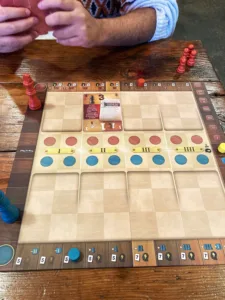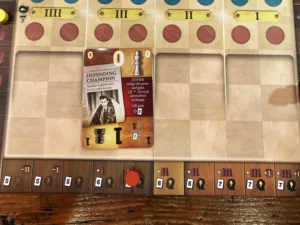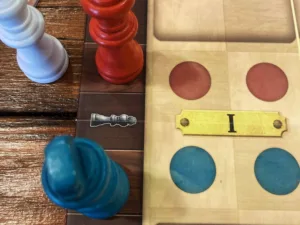 For several weeks when I was 5, when I got home from kindergarten, I knew where my mom would be: in front of the TV watching chess. It was 1972 and the whole world seemed to stop to watch American Bobby Fischer challenge the reigning world champion, Boris Spassky of the Soviet Union, in a chess match that served as another battlefront in the Cold War. I had no idea how to play chess (nor did I understand the geopolitical ramifications of the two players’ nationalities) but I loved how intently my mother was watching the PBS recreations of the matches. And now it’s a board game!
For several weeks when I was 5, when I got home from kindergarten, I knew where my mom would be: in front of the TV watching chess. It was 1972 and the whole world seemed to stop to watch American Bobby Fischer challenge the reigning world champion, Boris Spassky of the Soviet Union, in a chess match that served as another battlefront in the Cold War. I had no idea how to play chess (nor did I understand the geopolitical ramifications of the two players’ nationalities) but I loved how intently my mother was watching the PBS recreations of the matches. And now it’s a board game!
“Match of the Century” by acclaimed designer, Paolo Mori, and published by Capstone Games, takes its cue from this famous chess duel, but rather than playing chess, you and your opponent will create the Spassky/Fischer battle in a two-person tug of war that is secretly a four-handed trick-taker played over six to twelve rounds.
Gameplay Overview
When you take Match of the Century out of the box and begin to set up, people will assume you’re about to play chess. There are a lot of wooden chess pieces: 2 Kings, one Queen, and a whole bunch of pawns. But in essence, the chess pieces are a head fake—this is a card game. And as a second head fake, while this game looks like it comes from the same DNA as Matthias’ Kramer’s Watergate (also published by Capstone), the only real similarities are the size of the box and a shared setting during the Nixon administration.
So, if it’s not chess and it’s not a straightforward tug-of-war like Watergate, what is it? It’s a two-person trick taker, where the tricks are worth 1, 2, 3, and 4 points and whoever gets more points over four hands wins the round (or if they tie, both win), and whoever wins six rounds first wins the Match… of the Century.

Game Experience:
The rules of Match of the Century are simple. Players fill their hand up to a limit set by their position on an endurance track, which ebbs and flows as the tricks are won or loss. The white player (whoever has the Queen) starts the round by picking one of four trick values, 1 through 4 points, and plays a card face up to the space indicated by that value. The other player responds with a card and the high player wins, gaining that many points towards deciding who wins the 4-trick round.
But there are wrinkles. Players start with a few pawns and can gain more through card play and on any trick, they may add one or two points to the value of the card played. So a four with two pawns added counts as a six, etc. Also, before the winner can claim the points for winning the hand, the loser triggers whatever bonus was on the losing card, which can earn extra pawns or cards, help the losing player gain other benefits, inflict harm on the winner, or sometimes even cancel the victory entirely.

Complicating all of this is the fact that every card has a white value and a black value, so that when you play as White, you use the cards white-side up, and if you are Black, you flip them black-side up. Each card has a pawn on one side and the other will be one of the other chess pieces. All the pawns are the same, worth 1 point with a minor bonus, but each has a different value on the other half of the card (which you will play when you are the other color).
Any given card can be a 1 for Black or a 1 for White, but then the other color, on the other side of each card, has values ranging from 2 to 5, plus a zero, and each has better bonuses as well.
About those bonuses. You only receive the card’s bonus if you lose the trick, and they can be very powerful. Here the game may remind you of Peer Sylvester’s Brian Boru: High King of Ireland, in that both games make you choose whether you want to win or lose the hand because sometimes the losing bonus offers more long-run benefit than the points awarded to the winner.

Whoever wins the first trick leads for the next trick. If ever one player has a big enough lead that the lead is insurmountable, the round ends, the winner’s King advances one space, the Queen is swapped and the players turn their cards from white-side-up to the black side or vice versa, and you play another round of four tricks. You do this until someone wins (or ties) 6 rounds; whoever gets there first wins, with 6-6 ties going to Spassky.
There are a few other spices thrown in. When you win the trick worth four points, you lose some stamina, which will tend to shrink your hand size and reduce the number of pawns you get at the start of a new round.
The card bonus sometimes gives the loser more stamina or takes some away from the winner of the trick. Other bonuses let the loser gain extra pawns or draw extra cards. But even drawing cards can be perilous, because every time you need to reshuffle your discards to start a fresh deck, you lose a stamina point in the process.

Each player in Match of the Century plays with different decks and the impact of a win or a loss has slightly different effects on each player, mostly through the stamina mechanism, but the deck and stamina-track asymmetry is not particularly major. You can swap sides and play almost the same way whether you’re the Soviet or the American. What matters more is whether you are playing as White or Black, because each card is meh on one side and wow on the other.
One of my opponents, who is very experienced at all sorts of games, was utterly confused by the fact that each card had one value (and bonus) when playing as White and a different value (and different bonus) when playing as Black. Turning the cards so the unused half had upside down text did not help. But, once he figured that aspect out, he began to plan ahead, thinking about whether the card he could play this round as black might be better saved to be used next round as white. This also makes the simple act of playing a bad card, a 1, into a bit of a puzzle, since the other side of each 1 in your hand has a different value and/or effect.
So why all the chess pieces? Well as mentioned above, the pawns are just boosters, letting you augment the value of a card by 1 or 2. Kings are used to keep track of how many rounds each player has won or tied. The Queen is just a reminder of who is the first player (White) each round. So they are all fancy record-keepers, but it does create a bit of a chessmosphere to an otherwise very cardy card game.
Final Thoughts:
I have played Match of the Century a dozen times now, and I still don’t know if I like it or not. It’s extremely clever, but it did not grab me anywhere near as much as those PBS broadcasts of the original Spassky/Fischer match did when I was five. If I had 3 to 5 players, I would play the aforementioned Brian Boru any time someone asked. Match of the Century brings some of those feels to a 2p game, but I think I would choose other 2p card duels over this one. So it’s fine, it’s fun enough, it’s interesting, and it’s unusual. But I am not sure it’s for me.
Final Score: 3 Stars – I think this would be a great addition to your collection if you like 2p trick-takers. And I think if that concept sounds intriguing you should definitely give this a try.
 Hits:
Hits:
• Clever dual-valued cards that gain and lose power every other round
• Standard 2p duel dynamics of trying to outguess your opponent
• Nice chunky pieces to confuse onlookers into thinking you’re about to play chess
Misses:
• As a genre, 2p trick taking isn’t nearly as fun as games for 3 or more
• Even smart gamers can be confused by the dual-valued cards





















